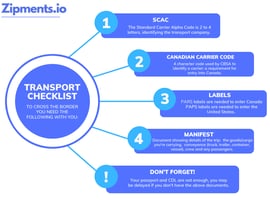The last thing you want is to end up stuck for days at the border because you don't have all of...
6 Common Cross-Border Mistakes You Want To Avoid
If you want to ship across the border, it will be important to ensure you follow all the steps in the process, and aim to avoid a few costly mistakes. Any delays, fines or potential need to redo documents, may result in more of an inconvenience for you. CBSA (Canada Border Services Agency) and CBP (U.S. Customs and Border Protection) are strict with their rules and regulations, especially when it comes to freight shipping. Taking note of some of the common mistakes in the process, is how you can ensure your shipment makes it safely across the border..png?width=6912&name=White%20Minimalist%20New%20Website%20Promo%20Banner%20%20(7).png) Some of the common challenges, or mistakes in cross border transport that could set you back include:
Some of the common challenges, or mistakes in cross border transport that could set you back include:
Not Hiring a Customs Broker
Though it may seem like an expense to hire a customs broker in the transportation process, this can actually save you time and money in the long run. Often companies end up hiring a broker too late, or they try to ship on their own, leading to errors in documentation or calculating fees/taxes. Brokers know the documents required and the duties, fees or taxes your shipment may need. If you also don’t properly label them, customs officers may have a harder time finding the info. These small steps can delay your shipment from crossing. Your broker can ensure you are compliant with all customs processes or requirements, so there is little surprise once you get to the border. Give yourself up to 2 weeks to hire one, as it can take about a week or so, for them to gather all your documents/become familiar with the carrier/shipper.
Word of Advice: Try to avoid shipping your freight until you have confirmed with the broker and make sure your data lines up, because they may still have paperwork to do and you don't want to ship with missing documents!
ACI/ACE Not Submitted/Accepted
Using the manifest portal is integral in the transportation process because it is how you can communicate data with customs. If your ACI/ACE is not accepted (you can check online), you may end up delayed. Canada requires the use of the ACI eManifest, otherwise things can get complicated. Meanwhile in the U.S., the ACE system helps CBP determine which imports are admissible. Since these serve as pre-arrival systems, they need to be submitted before you reach the border.
Driver Unaware of Cargo
In order to authenticate everything at customs, it is important for the driver to be able to answer some basic questions, including what it is they are transporting. If the drivers don’t know what their cargo is, then things can get confusing. You also want to make sure you have after hours contact information for the broker and carrier, in the case something occurs and they need to reach somebody. Provide applicable after hours contact info to the driver as well.
Missing Information (Goods, Consignee)
The name and address of the consignee are very important in the process, as they are the receiver of goods. You also need a clear description of the goods, the tariff number and weight data, as one of the steps in the process. To the point and plain descriptions of the goods are needed, any added words which are vague may be flagged: ie “miscellaneous, various, part etc.". Customs needs to clearly know what it is in your shipment, in order to assess and approve it quickly.
Hiring The Right Carrier
You also want to make sure your carrier is certified for cross border shipping. You want to hire somebody who has experience and knowledge shipping cross border. Extra pieces of certification can help speed up the process in cross border shipping, because border services will note that the carrier has been vetted already to some degree. For the US, you can ensure your carrier is certified under Free and Secure Trade (FAST) program or the C-TPAT with the CBP. Other certifications may include CSA, and PIP. This one’s not a requirement but it does help speed up the process. Certifications reflect to the CBP or CBSA that you are a low-risk carrier, thus is likely to speed up transit or border crossing.
Word of Advice: International commercial carriers need to have an international carrier bond on file according to CBP. The right carrier will need to know these regulations and uphold the rules.
Documents
Sometimes special instructions may be ignored if the driver does not read through their paperwork carefully. The dispatcher or carrier company or even shipper may provide special instructions so it’s important to check your documents before heading out. Ensuring that the info on the Bill of Lading and Customs Invoice match in terms of information included will be important in preventing any delays, which is why keeping up with documents is key. It is also important to ensure you have all the documents, which is why using one space like Zipments.io allows you to access or create relevant customs clearance forms and codes, so that you can communicate between broker and carrier more easily. Zipments streamlines the communication process, leaving less room to make mistakes.
Most of the common errors in cross border shipping usually have to do with documents, either documents are missing, improperly filled out or lacking. Once you have a system in place for gathering and organizing the documents, parties involved (driver, carrier, broker), it is easier to navigate the process. You also want to make sure to leave aside time for transit, as potential traffic or road delays may occur. Keeping these potential obstacles in mind, cross-border shipping can be a smooth and quick process!
If you are confused about any part of the cross border transport process, Zipments can help you out. Zipments.io works to make border crossing easy and quick for truck drivers and transportation companies. If you plan on transporting cross border, reach out via the Zipments website, and check out the chat bar at the bottom right of your screen!



